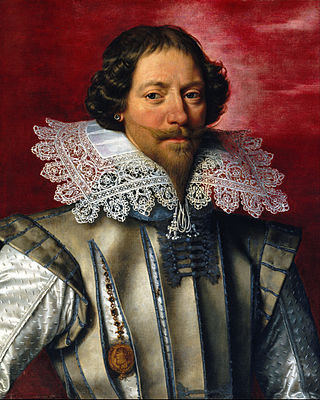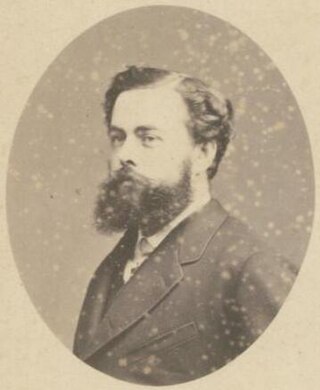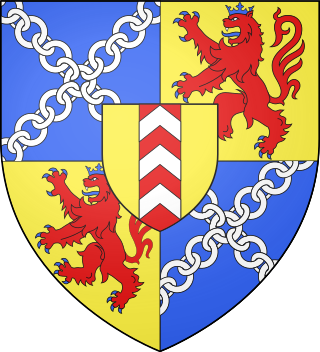
The title of Duke of Chaulnes (French : duc de Chaulnes), a French peerage, is held by the d'Albert family beginning in 1621.

The title of Duke of Chaulnes (French : duc de Chaulnes), a French peerage, is held by the d'Albert family beginning in 1621.


The duchy of Chaulnes was established by letters patent in January 1621 and registered on 6 March 1621 at the Parlement of Paris for the benefit of Honoré d'Albert (1581–1649), Marshal of France in 1619, known as the Marshal de Cadenet, a younger brother of Charles d'Albert, Duke of Luynes (1578–1621). [1]
Honoré d'Albert had married Charlotte Eugénie d'Ailly on 14 January 1620. She was heir to a family holding the titles of Count of Chaulnes (created in December 1563), Vidame d'Amiens and Baron de Picquigny. The marriage contract stipulated that their heirs would take the name and arms of Ailly. The first Duke of Chaulnes had three sons, all of whom took the surname of d'Albert d'Ailly. Of the three sons, only the eldest son Henri-Louis married, but only sired girls. Upon the first Duke's death in 1649, Henri-Louis became the second duke, and when he died four years later in 1653, the title passed to his younger brother, Charles, who became the third Duke. [2]
In 1667, to avoid the title passing into disuse, the 3rd Duke, at the request of his mother, named as his heir Charles Honoré d'Albert de Luynes, 7th Duke of Chevreuse (1646–1712), son of Louis Charles d'Albert de Luynes the 2nd Duke of Luynes. The Duke of Chevreuse's marriage contract stipulated that the title would pass to the youngest child of his marriage, [lower-alpha 1] and, in case the male line subsequently ended, to the youngest of that name who held the arms of the d'Albert family. Thus two distinct houses were created: Luynes, which the Duke of Chevreuse inherited from his father, and Chaulnes, which remained distinct and separate from the former until the direct line of inheritance came to an end. In that case, the two houses should be reunited until it was possible to separate them again (which happened in 1792). [4]
With the death of the 3rd Duke of Chaulnes, the first line of d'Albert d'Ailly ended and the duchy of Chaulnes went to the Duke of Chevreuse, Charles Honoré d'Albert de Luynes, who succeeded his father as the 3rd Duke of Luynes the following year in 1699. In 1694, he passed the duchy of Luynes to his eldest son Honoré Charles on the occasion of his marriage to Marie Anne Jeanne de Courcillon (a daughter of Philippe de Courcillon), and assigned the duchy of Chaulnes to his younger son Louis Auguste, Vidame d'Amiens, also on the occasion of his marriage in 1710. This transmission was confirmed by letters patent in October 1711, registered on 1 December 1711, which established Chaulnes as a duchy for the first time in favour of Louis Auguste's son, Charles François. Charles Honoré's eldest son was killed in 1704, and his grandson, Charles Philippe, inherited the duchy of Luynes upon the elder's death in 1712. [5]
In 1732, Charles Philippe d'Albert, the 4th Duke of Luynes, and, his uncle, Louis Auguste, the 4th Duke of Chaulnes, made an agreement whereby the former relinquished his rights over the duchy of Chaulnes, while the latter received confirmation which said that if the duchy of Chaulnes should return to the house of Luynes, it would pass to the youngest child of that family, and then remain in the direct male line (which happened in 1980). [6]
In 1792, upon the death of Louis Joseph d'Albert d'Ailly, the second d'Ailly line ended. Since then, the title of Duke of Chaulnes has been used as an irregular courtesy title in the d'Albert de Luynes family. It was first used by Charles Marie d'Albert de Luynes (a son of Louis Joseph d'Albert, 6th Duke of Luynes), who became the 7th Duke of Luynes in 1807. After Charles Marie's death in 1839, it passed to his son, Honoré Théodoric d'Albert de Luynes, Duke of Luynes, of Chevreuse and of Chaulnes. [7] In 1852, Honoré Théodoric passed it to his grandson Paul d'Albert de Luynes, who took the title of Duke of Chaulnes as a courtesy title. He owned the Château de Sablé. The duchy passed to his son in 1881 and then his son in 1908. [8] Upon the latter's death in 1980, the line ended again and the title reverted to the Duke of Luynes.
Today, the title is carried today as a courtesy title by a younger brother of the penultimate Duke of Luynes. [9] [lower-alpha 2]
The dukes of Chaulnes since 1621: [11]
| Number | From | To | Duke of Chaulnes | Relationship to predecessor |
|---|---|---|---|---|
| 1 | 1621 | 1649 | Honoré d'Albert (1581–1649) [11] | 1st Duke of Chaulnes (brother to Charles d'Albert, 1st Duke of Luynes) [12] |
| 2 | 1649 | 1653 | Henri Louis d'Albert d'Ailly (1620–1653) [11] | Son of the former |
| 3 | 1653 | 1698 | Charles d'Albert d'Ailly (1625–1698) [11] | Brother of the former and son of the 1st Duke of Chaulnes |
| 4 | 1698 | 1711 | Louis Auguste d'Albert d'Ailly (1676–1744) [11] | Son of Charles Honoré d'Albert, 3rd Duke of Luynes [12] |
| 5 | 1711 | 1731 | Charles François d'Albert d'Ailly (1707–1731) [11] | Son of the former |
| 6 | 1731 | 1769 | Michel Ferdinand d'Albert d'Ailly (1714–1769) [11] | Brother of the former |
| 7 | 1769 | 1792 | Louis Joseph d'Albert d'Ailly (1741–1792) [11] | Son of the former |
| 8 | 1792 | 1839 | Charles Marie Paul André d'Albert de Luynes (1783–1839) [11] | Son of Louis Joseph d'Albert, 6th Duke of Luynes |
| 9 | 1839 | 1852 | Honoré Théodoric d'Albert de Luynes (1802–1867) [11] | Son of the former |
| 10 | 1852 | 1881 | Paul Marie Stanislas Honoré d'Albert de Luynes (1852–1881) [11] | Grandson of the former [lower-alpha 3] [13] |
| 11 | 1881 | 1908 | Emmanuel Théodore Bernard Marie d'Albert de Luynes (1878–1908) [11] | Son of the former [14] [15] [16] [17] |
| 12 | 1908 | 1980 | Emmanuel Théodore Bernard Marie II d'Albert de Luynes (1908–1980) [11] | Son of the former |
| 13 | 1980 | Incumbent | Jacques François Marie Raymond d'Albert de Luynes (b. 1946) [11] | Son of Philippe d'Albert, 11th Duke of Luynes. |

Charles d'Albert, 1st Duke of Luynes was a French courtier and a favourite of Louis XIII. In 1619, the king made him Duke of Luynes and a Peer of France, and in 1621, Constable of France. Luynes died of scarlet fever near the end of that year at the height of his influence.

Duke of Chevreuse was a French title of nobility, elevated from the barony of Chevreuse in 1545.
The Duke of Luynes is a territorial name belonging to the noble French house d'Albert. Luynes is, today, a commune of the Indre-et-Loire département in France. The family of Albert, which sprang from Thomas Alberti, seigneur de Boussargues, bailli of Viviers and Valence, and viguier of Bagnols and Pont-Saint-Esprit in Languedoc, acquired the estate of Luynes in the 16th century.

Charles d'Albert, 3rd Duke of Chaulnes, was a French general and diplomat. He was made lieutenant général des armées in 1655, and chevalier des ordres du roi from 1661. He became third Duke of Chaulnes in 1653 on the death of his elder brother.

Honoré d'Albert, 1st Duke of Chaulnes, Marshal of France, Vidame of Amiens and Seigneur of Picquigny through his marriage to Claire Charlotte Eugénie d'Ailly, Countess of Chaulnes, was the first Duke of Chaulnes, a title created by Louis XIII in 1621.

Charles Honoré d'Albert de Luynes was a French nobleman and Duke of Luynes. He is best known as the Duke of Chevreuse, his family's subsidiary title which he used until his father's death in 1690. He was a high-ranking French official under King Louis XIV.

Michel Ferdinand d'Albert, 5th Duke of Chaulnes, Duke of Picquigny and then Duke of Chaulnes from 1744, was a French astronomer, physicist and freemason.
Charles Philippe d'Albert, 4th Duke of Luynes held the title Duke of Luynes from 1712 to 1758. He wrote an important memoir of life at the court of Louis XV.

Charles Louis d'Albert, 5th Duke of Luynes was a French nobleman and member of the House of Albert. He was the fifth Duke of Luynes as well as Duke of Chevreuse.
Philippe Anne Louis Marie Dieudonné Jean d'Albert, 11th Duke of Luynes was a French aristocrat who became the Duke of Luynes at the age of nineteen and held the title until his death in 1993.

Emmanuel d'Albert, 11th Duke of Chaulnes was a French nobleman.

Louis Charles d'Albert, 2nd Duke of Luynes, was a French nobleman and peer of France. He was a translator and moralist who was the first translator of the work of René Descartes.
Louis Joseph d'Albert, 3rd Prince of Grimberghen was a French nobleman who was in the service of the Emperor Charles VII, and became field-marshal and Ambassador in France.
Louis Emmanuel de Crussol, 14th Duke of Uzès was a French aristocrat and art collector.
Honoré-Louis d'Albert de Luynes, styledDuke of Chevreuse, was a French nobleman.

Charles Honoré Emmanuel d'Albert de Luynes, 9th Duke of Luynes was a French aristocrat and soldier in the Papal Zouaves.
Paul Marie Stanislas Honoré d'Albert de Luynes, 10th Duke of Chaulnes and Picquigny was a French aristocrat, soldier and writer.

Louis Joseph Charles Amable d'Albert, 6th Duke of Luynes was a French politician, nobleman and member of the House of Albert. He was the sixth Duke of Luynes as well as Duke of Chevreuse.

Charles Marie Paul André d'Albert, 7th Duke of Luynes was a French aristocrat and politician.

Honoré Charles Marie Sosthène d'Albert de Luynes, 10th Duke of Luynes was a French aristocrat and diplomat.